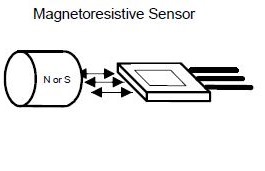Introduction:
Magnetoresistive sensors are devices that detect changes in magnetic fields by measuring variations in electrical resistance. They are highly sensitive and commonly used in applications such as position sensing, data storage, and current measurement, leveraging the magnetoresistive effect of certain materials.

Working principle:
Magnetoresistive Effect:
The fundamental principle behind magnetoresistive sensors is the change in electrical resistance of a material when exposed to a magnetic field. This change occurs in the direction parallel to the magnetic field applied to the magnetoresistive element.
Detection Mechanism:
These sensors primarily detect the angle of the magnetic field rather than its strength, allowing for a larger detectable area.
Magnetoresistive Effect:
The magnetoresistive effect is a phenomenon observed in certain materials where their electrical resistance changes in response to an external magnetic field. This effect is particularly pronounced in materials that exhibit magnetoresistance, such as ferromagnetic and some semiconductor materials.
Key Aspects of the Magnetoresistive Effect:
Change in Resistance:
- When a magnetic field is applied to a magnetoresistive material, the alignment of magnetic domains within the material changes. This alteration affects the movement of charge carriers (electrons) within the material, leading to a change in electrical resistance.
- The resistance can either increase or decrease depending on the material and the orientation of the magnetic field relative to the current flow.
Types of Magnetoresistive Elements:
Magnetoresistive elements are categorized based on their materials and operational principles. Each type has unique characteristics and applications:
Semiconductor Magnetoresistive Element (SMR):
Description: SMR utilizes semiconductor materials, such as silicon or germanium, to achieve magnetoresistance. These materials exhibit changes in resistance when exposed to a magnetic field due to the movement of charge carriers.
Applications: SMRs are often used in applications requiring precise magnetic field measurements, such as in automotive sensors and industrial automation. Their ability to integrate with existing semiconductor technology makes them suitable for various electronic devices.
Anisotropic Magnetoresistive Element (AMR):
Description: AMR elements exhibit resistance changes that depend on the angle between the magnetic field and the direction of the current flow. This effect is particularly pronounced in ferromagnetic materials, where the resistance can vary significantly based on the orientation of the magnetic field.
Applications: AMR sensors are widely used in automotive applications (e.g., wheel speed sensors), position sensing, and magnetic field detection in consumer electronics. Their ability to detect the angle of the magnetic field makes them valuable for precise measurements.
Giant Magnetoresistive Element (GMR):
Description: GMR elements show significant changes in resistance in response to a magnetic field, often several percent. This effect is observed in multilayered materials composed of alternating ferromagnetic and non-magnetic layers. The resistance change is due to the alignment of magnetic moments in the ferromagnetic layers.
Applications: GMR sensors are commonly used in hard disk drives for reading and writing data, as well as in magnetic field sensing applications. Their high sensitivity and fast response times make them ideal for data storage technologies.
Tunnel Magnetoresistive Element (TMR):
Description: TMR operates based on quantum tunneling, where electrons tunnel through an insulating barrier between two ferromagnetic layers. The resistance of the junction changes significantly depending on the relative alignment of the magnetic moments in the ferromagnetic layers.
Applications: TMR sensors are known for their high sensitivity and are used in applications such as magnetic random-access memory (MRAM), data storage devices, and precision magnetic field sensing. Their ability to operate at low power levels makes them suitable for battery-operated devices.
Advantages of Magnetoresistive Sensors:
- High Sensitivity: Magnetoresistive sensors are capable of detecting minute changes in magnetic fields, often in the range of microtears or even lower. This high sensitivity allows for precise measurements in applications such as data storage, position sensing, and navigation systems.
- Compact Size: These sensors are typically smaller than many other types of magnetic sensors, making them suitable for integration into compact electronic devices. Their small form factor allows for easy placement in tight spaces, which is particularly beneficial in consumer electronics and automotive applications.
- Low Power Consumption: Magnetoresistive sensors operate with minimal energy, making them ideal for battery-powered devices. Their low power requirements help extend battery life in portable applications, such as wearables and mobile devices, where energy efficiency is crucial.
- Temperature Stability: Magnetoresistive sensors provide consistent performance even with fluctuations in temperature. This stability is essential in applications where environmental conditions can vary, such as in automotive and industrial settings. The ability to maintain accuracy across a range of temperatures ensures reliable operation in diverse conditions.
Limitations of Magnetoresistive Sensors:
- Higher Cost: Generally, more expensive compared to other magnetic sensors.
- Need for ESD Protection: Requires additional circuitry to protect against electrostatic discharge.
Applications of Magnetoresistive Sensors:
- Data Storage Devices: Used in hard drives and magnetic recording systems for reading and writing data.
- Position Sensing: Employed in robotics and automation for precise position measurements.
- Current Measurement: Utilized in electrical applications to measure current flow through conductors.
- Automotive Applications: Used for wheel speed sensing and detecting the position of various components.
- Metal Detection: Effective in detecting metal objects in various environments.
Conclusion:
Magnetoresistive sensors are essential components in modern technology, offering high sensitivity and versatility across numerous applications. Their ability to accurately measure magnetic fields makes them invaluable in fields ranging from data storage to automotive systems.